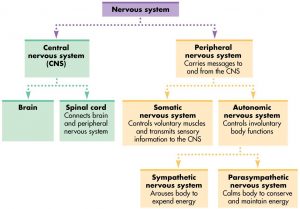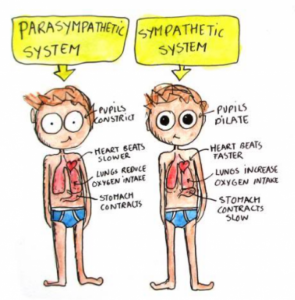 Deep breathing is proven to help people feel better and live better. Even so, many people find that it doesn’t work for them. If you’ve tried deep breathing but can’t make it work, this article is for you. It’s broken into two parts – the theory of it, which explains how it works, and the practice of it, which explains how to do it. I’m including how it works – the ways it changes your body’s response to “triggers” – because understanding the mechanics of deep breathing may help you get better results from the how to do it section which follows.
Deep breathing is proven to help people feel better and live better. Even so, many people find that it doesn’t work for them. If you’ve tried deep breathing but can’t make it work, this article is for you. It’s broken into two parts – the theory of it, which explains how it works, and the practice of it, which explains how to do it. I’m including how it works – the ways it changes your body’s response to “triggers” – because understanding the mechanics of deep breathing may help you get better results from the how to do it section which follows.
DEEP BREATHING
The Theory (AKA How It Works)
Stress, anger, worry, grief – these emotions trigger our nervous systems and leave us feeling distressed. Done properly, deep breathing takes advantage of the way our nervous systems work to return us to calm.
Way back when, animals that could fight better, run faster, or stay hidden longer survived longer than those that lost the fight, couldn’t run fast enough, or were found. Animals that survived and were able to reproduce, reproduced; animals that did not, did not, generation after generation. Fast forward approximately 200,000 years, and “survival of the fittest” has evolved into what is often called the “fight or flight” response. In other words, when our bodies sense a threat, our brains send signals to our nervous systems, which in turn activate our bodies to survive the (real or imagined) threat.
This response comes in handy in the case of real danger because we experience a host of physical responses that prepare us to meet the threat. Our hearts beat faster, we breathe more shallowly, and our focus shifts from internal (like reading a book) to external (like looking over our shoulders for a threat). Our focus on what is external is why it is so hard to concentrate when we are nervous – our attention and energy are diverted towards the (external) threat.
The problem is that our bodies can deliver a massive dose of those same responses when we only need a little boost for top performance: when we’re getting ready to make a presentation at work or school, when we have an argument, or when we have to take a driving test. Too massive a dose can lead to panic attacks, but even everyday stress can lead to problems concentrating, high blood pressure, Irritable Bowel Syndrome, and chronic pain. These instinctive responses — that helped us survive as a species — aren’t always helpful in our modern-day world.
 The Nervous System
The Nervous System
These responses are controlled by our nervous system. People who study the nervous system named its different parts. For the purpose of relaxation, we need to know about the parasympathetic nervous system and the sympathetic nervous system.
Our sympathetic nerves are the ones which prepare your body for “fight or flight”: they dilate our pupils, increase our heartbeats, and make it so our stomachs slow down the processing of food. Our parasympathetic nerves do the opposite: they prepare our bodies for “rest and digest.” Our pupils constrict, our stomachs and salivary glands go back to work, our heartbeats slow, and our breathing returns to normal.
The sympathetic/parasympathetic responses are automatic; most of us can leave it to our bodies to figure out how much “fight or flight” we need, and when we need it. Some of us, though, find that our bodies are stuck on stressed (or anxious or angry or…). Our sympathetic nervous systems keep getting us ready to respond to a nonexistent threat, leaving our nerves raw and on edge.
 Deep Breathing and the Nervous System
Deep Breathing and the Nervous System
Here is where “deep breathing” comes in: we have learned that we can use breathing to return control to our parasympathetic nervous system’s responses. When we take slow and deep breaths, pulling air all the way down into our cores, we are signaling to our sympathetic system that there is no threat, that it is OK to return to “rest and digest” mode. It only works, however, if we engage in truly deep and slow breathing.
This is where we struggle with deep breathing: we would not be trying to use deep breathing if our bodies were not already stressed. Because we are stressed, it feels more natural to do the opposite of deep breathing. Shallow and short breaths feel right; using deep and long breaths feels like we’re going against our own bodies and instincts.
It feels that way because we are: we are overriding our instinctive responses and activating our parasympathetic systems. We are using deep breathing to tell our bodies that it’s time to calm down, get centered, and start paying attention. Our bodies are thinking something else entirely! So: know that we are overriding our instinctive responses… and know that everything will be OK.
Bringing about calm and relaxation in ourselves is an intentional process, described in the next part of this blog: DEEP BREATHING: The Practice.
DEEP BREATHING
The Practice (AKA How To Do It)
We’re angry, sad, or anxious. We want to return to a calm state. Breathe, we’re told. But how? There are many, many how-to articles, blogs, and videos on deep breathing. The process I’m describing here is much as I describe it to my clients in practice, and is the product of years of testing, researching, and adjusting. It is a combination of biomechanics, meditation, and mindfulness.
In practice, I always include a discussion of the “why,” even though most clients are more interested in the “how.” The reason is that understanding the “why” makes the instructions in the “how” more meaningful and easier to apply.
As with any relaxation technique, results vary from person to person. Find the method that works best for you. If this article helps you: wonderful. If not, Googling “deep breathing” generated around 202,000,000 results for me. With luck, you’ll find something you can use in there somewhere.
Breathing, done properly, is a way for us to return to a calm state, but I have found it does not work unless we create the correct conditions in our bodies. Remember, we’re not just trying for deep breaths: we’re trying to get control of our sympathetic nervous system. This means that deep breathing is more than taking big inhales and slow exhales. It means committing to this process with the intent and expectation of calming ourselves. Half-hearted attempts will yield half-hearted results.
Anytime, Anywhere
Some good news: we can do deep breathing anytime, anywhere we need it. We can do deep breathing sitting in a chair, laying down, or standing. No matter where we are or what we are doing, the first step is to ground ourselves.
If we’re standing, we spread our feet shoulder width apart, and feel our weight supported entirely, safely, and securely. We acknowledge that we aren’t going anywhere in this moment, and that we are safe to take this time to breathe. If we’re sitting, we feel our hips, thighs, and butts supporting us. If we are laying down, our weight is supported by our backs and shoulders.
No matter which position we are in, before we start, we take a moment to experience our connection to the ground, to the earth, or to whatever is solid and permanent in your universe. Our brains must know that we are safe and secure if we are to convince our emotional systems that we are safe and secure.
Now, we attend to our postures. We straighten our spines, bring our shoulders back, and lift our chins. This increases the capacity in our lungs, which is important because we cannot breathe deeply if our lungs are deflated and collapsed due to poor posture.
When we are ready, we start paying attention to our breathing. We don’t try to change it at first: we just notice it. Is it slow, or fast? Deep, or shallow? We must make ourselves aware of our breathing if we are to change it in a way that brings us to calm.
Next, we notice our environment. What are we touching, what are we seeing, what are we smelling? We are going to close our eyes soon: will we be completely safe? We will not get our parasympathetic nerves to join with us unless our brains are sure it is safe.
When our brains are convinced that we are safe, it is time for us to close our eyes and take our first long, slow, deep breath. When we’re ready, we let the breath out slowly, and then return to breathing normally.
Now, I’m changing the voice of this article. Instead of talking about us, I’m talking to you (it will make the steps easier to follow).
Visualization
Visualize, in your mind’s eye, a mountain. The mountain is made of granite, and has been there for millions of years, and will remain just as it is, for millions of years. In front of the mountain is a lake, so smooth its surface reflects the mountain perfectly, as well as the fresh fields of wildflowers surrounding it.
Feel how your body, through your feet, hips, or shoulders connects to that mountain and take another deep, slow, breath as you picture the beautiful reflecting lake. Maintain your slow and steady breathing, in and out.
You probably are having thoughts – distractions – coming into your mind. We’ll come back to them shortly. For now, just let them be and keep your attention on the mountain, the lake, and the fields of wildflowers.
It’s time to transition your focus to your breathing. Take a deep, slow breath and exhale slowly. Feel the connection between yourself and the mountain. Accept your connection with it and feel its million years of placid stability and permanence. Keep breathing deep, slow breaths, inhaling slowly and exhaling even more slowly. As you do, notice the fresh air, and the scent of the wildflowers.
Managing Stray Thoughts
Your thoughts, I am sure, are still coming in. Greet them as they arrive; acknowledge them, and then visualize them reflecting off the lake and disappearing in the distance. Yes, some thoughts return. Greet them again, for they are old friends. But, let them know that you will tend to them later, and send them to reflect off the lake and drift off into the distance.
Keep breathing, sensing the serenity, the permanence of the mountain. Keep breathing, slowly, deeply, so that you can appreciate the air, and the scents of the wildflowers.
Now that you are safe, connected with your mountain, and breathing fresh air, notice and welcome any thoughts that continue to come. Greet them as if they are friends, because they have been with you for many visits. You know you can let them be without your attention while you take this break. If some thoughts continue to insist on your attention, know that they bring nothing urgent to you; nothing that needs your attention right now. Promise to get back to them later as you visualize them reflecting off the lake and drifting off into the distance.
Take your time enjoying your break in the fresh mountain air. When you are ready, open your eyes and return. Peace to you.

 Deep Breathing and the Nervous System
Deep Breathing and the Nervous System


